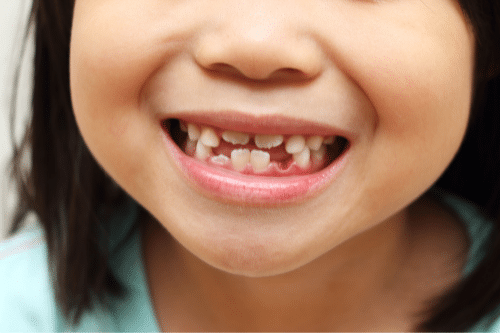
Children have 20 baby teeth, all of which typically erupt by age three. Also known as primary teeth, the first set of teeth allow children to move beyond consuming only milk and pureed baby food to most solid food. The primary teeth fall out one at a time to make room for permanent teeth that have erupted beneath the gum line. This process starts around age five and continues until the late childhood years.
Some children’s permanent teeth erupt late, and other children go several months between losing primary teeth. Dentists often recommend space maintainers in these situations.
What Are Space Maintainers?
Space maintainers are customized dental devices consisting mainly of metal and acrylic material. Some types are removable, and others remain in a child’s mouth permanently or until a dentist removes the adhesive material that allows it to stay in place.
The purpose of a space maintainer is to keep the spot on a child’s gum line open until the entire permanent tooth grows in. The risk in not maintaining a gap left by primary teeth is that other teeth can shift towards the open position and cause a bite misalignment. Children with this issue typically need braces when they reach the teenage years.
What Parents Should Know About Removable Space Maintainers
A removable space maintainer looks and functions like other removable dental devices, such as a retainer. Acrylic is the primary type of material used to create this type of space maintainer. Pediatric patients simply discard the removable space maintainer once permanent teeth come in and they no longer need it.
Options for Non-Removable Space Maintainers
Dentists at Smile First Pediatric Dentistry install permanent space maintainers in a child’s mouth by using dental cement to affix it to one or more teeth. These are the most common types of space maintainers:
- Crown and loop: Before installing this type of permanent space maintainer, a dentist places a crown over the tooth and attaches a thin loop to it. Adding the loop is essential to give the permanent tooth plenty of room to erupt and grow in later.
- Distal shoe space: Dentists primarily use this type of non-removable space maintainer to leave space for the back molar teeth that typically do not come in until a child is around 12 years old. A piece of metal from the devices goes into the gum line to prevent the open space from closing.
- Lingual: Children who have several consecutive primary teeth missing can benefit from a permanent lingual space maintainer. This device cements to the inside of molar teeth.
- Unilateral: The unilateral permanent space maintainer contains a metal loop and wraps around a single tooth.
Schedule a Consultation to Learn More About Space Maintainers
Space maintainers are much more affordable and less invasive than braces. Smile First Pediatric Dentistry invites parents to call our office with additional questions or schedule an appointment for their child.
